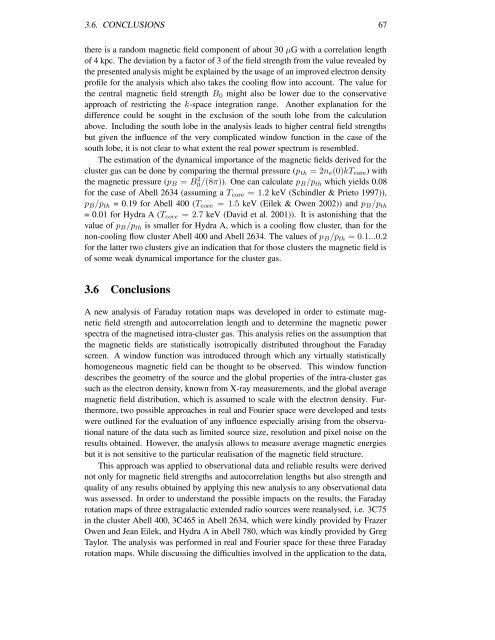Investigations of Faraday Rotation Maps of Extended Radio Sources ...
Investigations of Faraday Rotation Maps of Extended Radio Sources ...
Investigations of Faraday Rotation Maps of Extended Radio Sources ...
You also want an ePaper? Increase the reach of your titles
YUMPU automatically turns print PDFs into web optimized ePapers that Google loves.
3.6. CONCLUSIONS 67<br />
there is a random magnetic field component <strong>of</strong> about 30 µG with a correlation length<br />
<strong>of</strong> 4 kpc. The deviation by a factor <strong>of</strong> 3 <strong>of</strong> the field strength from the value revealed by<br />
the presented analysis might be explained by the usage <strong>of</strong> an improved electron density<br />
pr<strong>of</strong>ile for the analysis which also takes the cooling flow into account. The value for<br />
the central magnetic field strength B 0 might also be lower due to the conservative<br />
approach <strong>of</strong> restricting the k-space integration range. Another explanation for the<br />
difference could be sought in the exclusion <strong>of</strong> the south lobe from the calculation<br />
above. Including the south lobe in the analysis leads to higher central field strengths<br />
but given the influence <strong>of</strong> the very complicated window function in the case <strong>of</strong> the<br />
south lobe, it is not clear to what extent the real power spectrum is resembled.<br />
The estimation <strong>of</strong> the dynamical importance <strong>of</strong> the magnetic fields derived for the<br />
cluster gas can be done by comparing the thermal pressure (p th = 2n e (0)kT core ) with<br />
the magnetic pressure (p B = B0 2/(8π)). One can calculate p B/p th which yields 0.08<br />
for the case <strong>of</strong> Abell 2634 (assuming a T core = 1.2 keV (Schindler & Prieto 1997)),<br />
p B /p th = 0.19 for Abell 400 (T core = 1.5 keV (Eilek & Owen 2002)) and p B /p th<br />
= 0.01 for Hydra A (T core = 2.7 keV (David et al. 2001)). It is astonishing that the<br />
value <strong>of</strong> p B /p th is smaller for Hydra A, which is a cooling flow cluster, than for the<br />
non-cooling flow cluster Abell 400 and Abell 2634. The values <strong>of</strong> p B /p th = 0.1...0.2<br />
for the latter two clusters give an indication that for those clusters the magnetic field is<br />
<strong>of</strong> some weak dynamical importance for the cluster gas.<br />
3.6 Conclusions<br />
A new analysis <strong>of</strong> <strong>Faraday</strong> rotation maps was developed in order to estimate magnetic<br />
field strength and autocorrelation length and to determine the magnetic power<br />
spectra <strong>of</strong> the magnetised intra-cluster gas. This analysis relies on the assumption that<br />
the magnetic fields are statistically isotropically distributed throughout the <strong>Faraday</strong><br />
screen. A window function was introduced through which any virtually statistically<br />
homogeneous magnetic field can be thought to be observed. This window function<br />
describes the geometry <strong>of</strong> the source and the global properties <strong>of</strong> the intra-cluster gas<br />
such as the electron density, known from X-ray measurements, and the global average<br />
magnetic field distribution, which is assumed to scale with the electron density. Furthermore,<br />
two possible approaches in real and Fourier space were developed and tests<br />
were outlined for the evaluation <strong>of</strong> any influence especially arising from the observational<br />
nature <strong>of</strong> the data such as limited source size, resolution and pixel noise on the<br />
results obtained. However, the analysis allows to measure average magnetic energies<br />
but it is not sensitive to the particular realisation <strong>of</strong> the magnetic field structure.<br />
This approach was applied to observational data and reliable results were derived<br />
not only for magnetic field strengths and autocorrelation lengths but also strength and<br />
quality <strong>of</strong> any results obtained by applying this new analysis to any observational data<br />
was assessed. In order to understand the possible impacts on the results, the <strong>Faraday</strong><br />
rotation maps <strong>of</strong> three extragalactic extended radio sources were reanalysed, i.e. 3C75<br />
in the cluster Abell 400, 3C465 in Abell 2634, which were kindly provided by Frazer<br />
Owen and Jean Eilek, and Hydra A in Abell 780, which was kindly provided by Greg<br />
Taylor. The analysis was performed in real and Fourier space for these three <strong>Faraday</strong><br />
rotation maps. While discussing the difficulties involved in the application to the data,
















